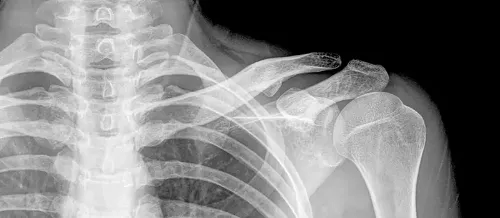Shoulder arthrosis (glenohumeral)
"The shoulder is the most frequently dislocated joint, especially in young people and athletes".
DR. ANTONIO ARENAS
SPECIALIST. ORTHOPEDIC SURGERY AND TRAUMATOLOGY DEPARTMENT

Glenohumeral osteoarthritis is the degenerative disease of the joint between the humeral head and the glenoid socket of the shoulder blade.
The arthrosis is the degenerative disease with loss of the cartilage that covers the articular surfaces, so that the space of the joint disappears.
Loss of articular cartilage and hardening of the bone surfaces with formation of osteophytes (bone growth on the periphery of the joint) occurs.

What are the symptoms of shoulder osteoarthritis?
They are often well tolerated and give little symptomatology. Sometimes the patient feels pain in the shoulder that radiates to the side of the arm.
The pain worsens when making movements and at night, in addition it is often accompanied of sensation of cracks in the articulation.
Over time, mobility is lost and the joint may become completely locked.
The most common symptoms are:
- Shoulder pain.
- Functional disability of the shoulder.
- Loss of strength.
- Joint stiffness.
Do you have any of these symptoms?
You may have osteoarthritis in your shoulder
What are the causes of shoulder osteoarthritis?
There are various causes that can lead to glenohumeral arthritis:
- A degenerative arthrosis type process.
- An old traumatism.
- An extensive rupture of the tendons of the shoulder.
How is osteoarthritis of the shoulder diagnosed?

For the diagnosis of shoulder osteoarthritis, of the glenohumeral joint, a few simple shoulder X-rays and a blood test will suffice to diagnose most glenohumeral arthropathies.
The standard radiographs for assessing the glenohumeral joint are the AP and axillary projection, which allow visualization of glenoid details.
Other explorations such as ultrasound, arthroscopy and MRI are indicated in case of suspicion of other associated pathologies.
How is osteoarthritis of the shoulder treated?
The aim of treatment is to relieve pain and maintain functional capacity
First of all, rest, anti-inflammatory and analgesic treatment, as well as physiotherapy measures, are recommended. If the response is not satisfactory, it may be recommended to inject delayed-acting corticoids into the glenohumeral joint.
Patients who do not respond to conservative treatment are advised to undergo surgery to place a prosthesis or shoulder arthroplasty.
The results of shoulder prostheses are currently very satisfactory, making it possible to eliminate pain and significantly improve mobility and joint function.
There are various models and possibilities that the orthopedic shoulder surgeon must adapt to each particular patient.
Where do we treat it?
IN NAVARRE AND MADRID
The Department of Orthopedic Surgery and Traumatology
of the Clínica Universidad de Navarra
The Department of Orthopedic Surgery and Traumatology covers the full spectrum of congenital or acquired conditions of the musculoskeletal system including trauma and its aftermath.
Since 1986, the Clinica Universidad de Navarra has had an excellent bank of osteotendinous tissue for bone grafting and offers the best therapeutic alternatives.
Organized in care units
- Hip and knee.
- Spine.
- Upper extremity.
- Pediatric orthopedics.
- Ankle and foot.
- Musculoskeletal tumors.

Why at the Clinica?
- Experts in arthroscopic surgery.
- Highly qualified professionals who perform pioneering techniques to solve traumatological injuries.
- One of the centers with the most experience in bone tumors.




















